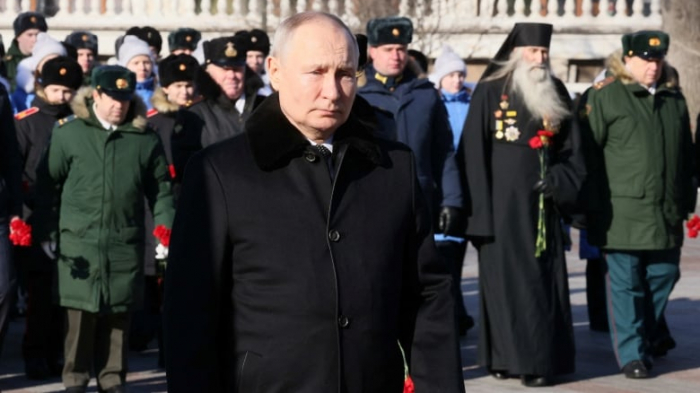While the sanctions regime imposed on Russia has dented its economy, it is far less severe than those imposed on North Korea and Iran, which included penalties on third-party countries. Imposing secondary sanctions could tighten the screws on Putin, but also accelerate deglobalization.
US President Joe Biden deserves all the praise he received for his recent trip to Ukraine and Poland to mark the first anniversary of Russia’s full-scale invasion. Biden’s ten-hour train ride from the Polish border to Kyiv – no small feat for an octogenarian leader – completely pre-empted Russian President Vladimir Putin’s propaganda plans for the occasion. It was a great day for Ukraine, the United States, and its NATO allies.
But when, during a speech at the Royal Castle in Warsaw, Biden claimed that the current sanctions on Russia represent “the largest sanctions regime ever imposed on any country in history,” his statement, though accurate, was also misleading. The sanctions that the US has used elsewhere, for example on North Korea and Iran, have been far more severe than the current sanctions on Russia, because they include secondary sanctions on third-party countries that continue to trade with these regimes. In the case of Russia, this is only just starting.
For now, Russia continues to sell oil to India and China and buy fresh fruits and vegetables from Israeli exporters. Moreover, a huge amount of trade takes place through so-called transshipments. To be sure, European exports to Russia have plummeted in line with the sanctions regime. But at the same time, the trade volume between Russia and countries like Turkey, Armenia, Kazakhstan, and Kyrgyzstan has shot up.
As a result, the sanctions have not hit Russia’s economy nearly as hard or as fast as expected. In the early days of the war, the US surprised even seasoned veterans of international finance when it swiftly froze $300 billion of Russia’s official foreign-exchange reserves. When Apple Pay and Google Pay were suspended in Russia, many hoped that Moscow’s subways would come to a standstill. But while Russia’s GDP was projected to shrink by at least 10%, the International Monetary Fund now estimates that the Russian economy contracted by just over 2% in 2022, and even expects it to grow slightly this year.
To be sure, there are plenty of reasons to be skeptical of the GDP numbers, which for the Kremlin are just a propaganda tool to convince European countries and their allies that sanctions are hurting them more than they are hurting Russia. Nevertheless, it is clear that the current sanctions regime has failed to devastate the Russian economy, as Western leaders had hoped.
But economic sanctions alone were never going to be enough to topple Putin’s regime. After all, the only reason why sanctions succeeded in South Africa in the 1980s and early 1990s was that the world was largely united against South African apartheid. But that was clearly an exception to the rule.
Where sanctions have really mattered is on the battlefield. While not as economically crippling as some had hoped, Western sanctions on military technology and components have curtailed Russia’s ability to replenish its reserves of high-precision missiles. Although some of the computer chips used in both civilian and military equipment have surely found their way to Russia, there is no doubt that the difficulties in obtaining specialized chips have taken a toll.
But that is not enough. The sanctions did not stop Russia from finding enough chips to cover large parts of Ukraine with smart landmines. According to some estimates, 30% of Ukraine is now covered with mines, particularly the northeast. These devices, which are prohibited by the 1997 Mine Ban Treaty (to which Russia is not a party), could hinder Ukraine’s recovery for years. And Russia has managed to do this without China openly supplying it with military technology, a risk scenario that the Biden administration has recently highlighted.
Biden may have been wrong in describing the EU-US-led sanctions regime as the most extensive ever imposed on any country, but he was not entirely off-base. The financial sanctions, in particular, are wide-ranging and complex, with some even targeting Putin himself. But the sanctions have been designed so that Russia can keep exporting anything but oil (for which it still has plenty of buyers) relatively freely. For example, it is awkward indeed that the US, which gets almost 20% of its electricity from nuclear power, is still importing Russian uranium.
Russia was running significant trade surpluses prior to the invasion, so it still has ample access to hard currency for imports, even if it has to pay more for rerouting them, and even if the range of goods it can buy has diminished. To tighten the screws on Putin’s regime, the US and its allies must get serious about secondary sanctions.
But that is easier said than done. While some have suggested that secondary sanctions could trigger a global recession, such fears are likely overstated. The bigger issue is that non-aligned countries such as India and Russian allies such as China do not share the West’s moral indignation over the invasion of Ukraine. Imposing secondary sanctions could accelerate the process of deglobalization that has been the subject of much analysis over the past year (though so far largely absent from trade numbers).
While Biden and NATO will most likely try to avoid this outcome, they might be pushed to cross the Rubicon if, say, Putin uses a tactical nuclear weapon in Ukraine. Many commentators believe this “Armageddon” scenario would never happen, and I hope that they are right. But if Putin is backed into a corner (perhaps following a Ukrainian spring offensive) and takes that step, China and India would be expected to stop trading with Russia. If they refused, the US and its allies would have no choice but to actually impose the most severe sanctions regime the world has ever seen.
Kenneth Rogoff, Professor of Economics and Public Policy at Harvard University and recipient of the 2011 Deutsche Bank Prize in Financial Economics, was the chief economist of the International Monetary Fund from 2001 to 2003. He is co-author of This Time is Different: Eight Centuries of Financial Folly (Princeton University Press, 2011) and author of The Curse of Cash (Princeton University Press, 2016).
More about:
















































